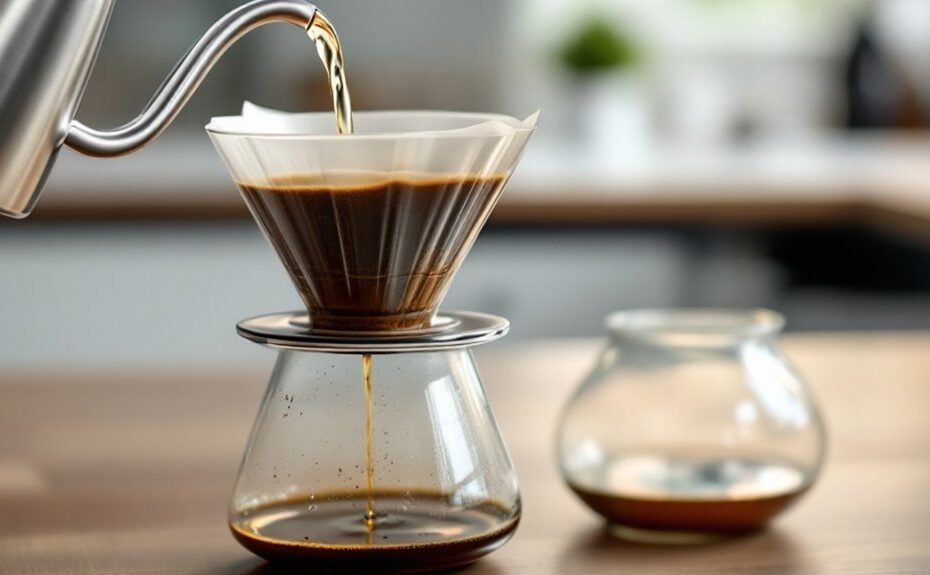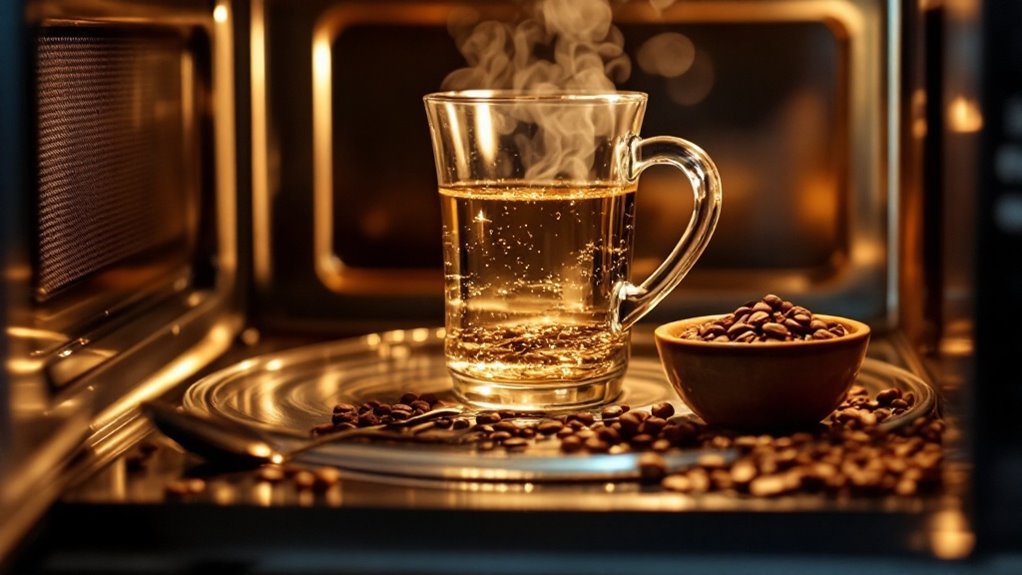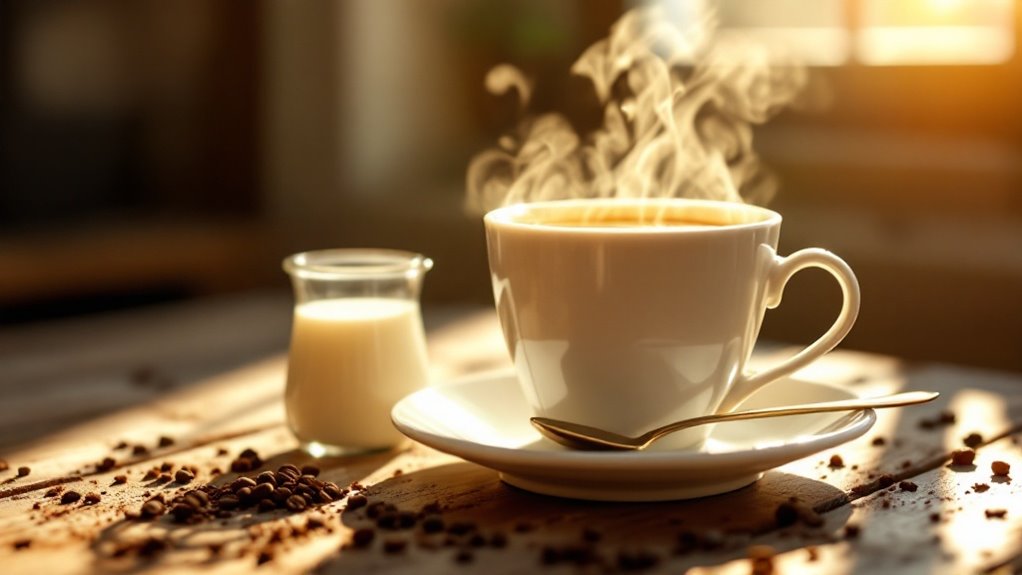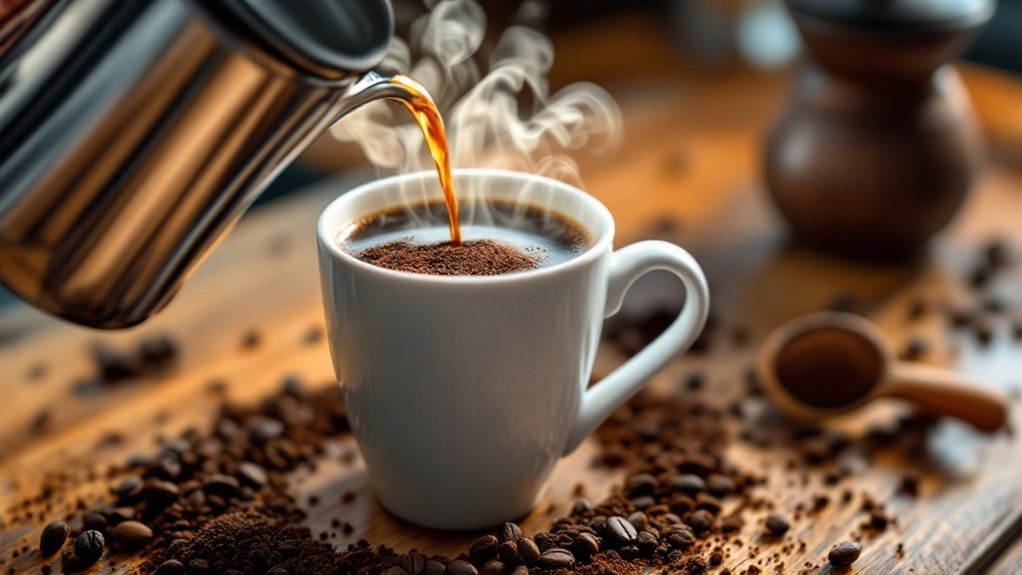







You might think brewing the perfect cup of coffee is as simple as tossing grounds into water, but the ratio you choose can make or break your brew. Whether you're using a French press, drip machine, or espresso maker, the balance between coffee and water determines everything from flavor to strength. But here's the catch: there's no one-size-fits-all answer. Your ideal ratio depends on your brewing method, personal taste, and even the type of beans you're using. So, how do you find that sweet spot? The answer lies in understanding the nuances of each variable—and that's where things get interesting.
Key Takeaways
- The standard coffee-to-water ratio is 1:16 (1 gram coffee to 16 grams water), ideal for balanced flavor in most brewing methods.
- French press requires a 1:15 ratio for stronger extraction, while drip coffee works best with a 1:17 ratio for lighter results.
- Adjust ratios based on roast level: lighter roasts may need more coffee, darker roasts less to avoid bitterness.
- Use a gram scale for precise measurements; volume-based methods (e.g., tablespoons) are less accurate due to density variations.
- Brewing parameters like grind size, water temperature (195°F–205°F), and brew time also influence the optimal coffee-to-water ratio.
Understanding Coffee-to-Water Ratios
To brew a consistently great cup of coffee, you'll need to nail the coffee-to-water ratio, which determines the strength and flavor of your brew. The ratio refers to the weight of coffee grounds relative to the weight of water used during brewing. For drip coffee, a standard ratio is 60 grams of coffee to 1 liter of water, or a 1:17 ratio. This guarantees a balanced extraction without overpowering bitterness or weak flavor. For full immersion methods like French press, a tighter ratio of 1:15 (e.g., 60 grams of coffee to 900 grams of water) is recommended to compensate for longer extraction times. If you're brewing a single cup, aim for a 1:16 ratio, such as 25 grams of coffee to 400 grams of water. Always measure your coffee and water by weight in grams for precision, as volume measurements like tablespoons can vary. Pair your ratio with water heated to 195°F–205°F for ideal extraction. Too cool, and your coffee will taste under-extracted; too hot, and it risks bitterness. Mastering these ratios guarantees a consistent, flavorful cup every time.
The Golden Ratio for Perfect Brewing
The Golden Ratio for brewing coffee, 1:16, balances strength and flavor by using 1 gram of coffee for every 16 grams of water. This coffee to water ratio guarantees ideal extraction, delivering a well-rounded cup without over-extraction or bitterness. For a standard 12-cup pot, measure 72 grams of coffee grounds (approximately 10 tablespoons) and combine it with 1.2 liters (40 ounces) of water. Adjust the ratio slightly depending on your brewing process: for drip or pour-over methods, a 1:17 ratio works best, while full immersion methods like French press require a tighter 1:15 ratio due to longer contact times between coffee grounds and water. Always measure by weight for precision, as volume measurements can vary. Pair the Golden Ratio with the correct water temperature—195°F to 205°F—to maximize flavor extraction. Consistency in your coffee brewing technique, combined with these precise measurements, guarantees a balanced and repeatable result every time. Experiment within these parameters to fine-tune your brew to personal preference, but always start with the Golden Ratio as your foundation.
How Brewing Methods Affect Ratios
Different brewing methods demand specific coffee-to-water ratios to maximize flavor extraction and achieve the desired strength. When brewing coffee with a French Press, you'll use a 1:15 ratio due to its immersion brewing process. The coarse grind size and extended brew time (4-5 minutes) allow water to fully saturate the coffee particles, extracting rich, full-bodied flavors. For pour-over methods like V60 or Chemex, a 1:16 to 1:17 ratio works best. The finer grind size and controlled water flow guarantee balanced extraction, producing a clean, nuanced cup. Espresso requires a concentrated 1:2 ratio, as the high pressure and fine grind size extract intense flavors quickly, creating a thick crema. Cold brew, on the other hand, uses a 1:8 ratio to compensate for the lower extraction efficiency of cold water during its 12-16 hour brew time. The AeroPress offers flexibility, with ratios ranging from 1:10 for a strong shot to 1:16 for a milder cup, depending on your grind size and brew time. Adjusting ratios based on your brewing method guarantees the best possible results.
Measuring Coffee and Water Accurately
Accurate measurement of coffee and water is the cornerstone of brewing a consistently great cup. To make coffee at home like a pro, invest in a gram scale. Coffee drinkers often rely on volume measurements like tablespoons, but weighing your coffee guarantees precision. Use a basic kitchen scale that measures to the nearest gram for most brewing methods. For advanced techniques like espresso, consider high-tech scales like the Acaia Pearl for extra accuracy.
When measuring the amount of coffee, aim for consistency by weighing your beans or grounds. Coffee density varies by roast level and origin, so volume measurements can lead to inconsistencies. If you don't have a scale, use 1 tablespoon of coffee per 4 ounces of water as a rough guideline, though this method is less reliable.
Store coffee in an airtight container to maintain freshness, and always measure your coffee and water before brewing. Whether you're using a drip coffee maker or a manual pour-over, precise measurements guarantee you'll achieve the perfect balance every time.
Adjusting Ratios for Strength and Flavor
To adjust your coffee's strength and flavor, consider how grind size impacts extraction—finer grinds increase surface area, requiring shorter brew times to avoid over-extraction. Use filtered water with a TDS (total dissolved solids) level of 150 ppm for ideal flavor clarity, as impurities can skew taste. Control brew time precisely; for example, aim for 2-4 minutes with a French press or 2-2.5 minutes with an AeroPress to balance extraction and avoid bitterness.
Grind Size Impact
Grind size plays a critical role in determining the coffee-to-water ratio needed for balanced extraction and flavor. Finer grind sizes increase the extraction rate, meaning water interacts more with the coffee surface area. This requires a shorter brew time and often a lower coffee-to-water ratio to prevent over-extraction, which can make your coffee taste bitter. For example, espresso uses a fine grind with a 1:2 ratio (18g coffee to 36g water) and a 25-30 second brew time for ideal results. Conversely, coarser grind sizes slow extraction, so you'll need a higher coffee-to-water ratio or longer brew time to achieve full flavor. French press brewing, which uses a coarse grind, typically employs a 1:15 ratio to balance strength and avoid excessive sediment. Adjusting grind size allows you to fine-tune extraction, ensuring consistent flavor and strength across brewing methods. Always match your grind size to your brewing technique and desired coffee-to-water ratio to avoid under- or over-extraction, which can compromise taste.
Water Quality Influence
Water quality substantially impacts the coffee-to-water ratio and overall flavor of your brew. Use filtered or bottled water to avoid impurities that can alter coffee tastes, guaranteeing a clean and consistent extraction. Cold tap water is ideal, as hot water systems often accumulate minerals and odors that degrade flavor. Avoid distilled or softened water, as they lack essential minerals like calcium and magnesium, which are critical for proper extraction and flavor balance. Hard water, with higher mineral content, can enhance coffee tastes but may require adjusting the ratio to prevent over-extraction. For example, reduce the coffee-to-water ratio slightly if your water sits in a high-mineral environment. Maintain a brewing temperature of 93°C ± 3°C to optimize extraction; temperatures outside this range can lead to under-extraction or bitterness, depending on the kind of coffee you're using. Always reserve the right to tweak ratios based on your water's mineral profile and the specific coffee you're brewing. Precision in water quality guarantees your coffee tastes as intended, every time.
Brew Time Control
Brew time is a critical factor in determining the strength and flavor profile of your coffee. For drip coffee, aim for a brew time of 3-6 minutes to balance strength and avoid over-extraction. Use 1-2 tablespoons of ground coffee for every 6 ounces of water to find the perfect ratio. If you're using a French press, steep your ground coffee for 4 minutes with a 1:15 coffee-to-water ratio to guarantee peak flavor extraction. For espresso, a fine grind and a 20-30 second brew time yield a concentrated, rich shot. Cold brew requires a coarse grind and a 12-16 hour steep time to achieve a smooth, low-acidity result. Adjust your brew time based on roast level: shorten it for lighter roasts to highlight delicate flavors, and extend it for darker roasts to enhance boldness. By controlling brew time and using the right amount of ground coffee for every cup, you'll extract much coffee flavor without bitterness. Experiment to find the perfect balance for your preferred method.
Common Mistakes in Coffee-to-Water Ratios
A heaping scoop of coffee grounds might seem like a shortcut to a stronger brew, but it's a common misstep that leads to over-extraction, leaving your coffee bitter and flat. Overloading your coffee maker with extra tablespoons of ground coffee extracts too many soluble flavors, overwhelming your palate. Conversely, using less coffee than needed results in under-extraction, producing a sour, salty cup. Always measure by weight (grams) rather than volume (tablespoons) for consistency, as freshly roasted coffee can vary in density. Ignoring grind size and brew time compounds these issues; a fine grind with a long extraction overpowers delicate notes, while a coarse grind with a short brew under-develops flavors. For cold brew, use a higher coffee-to-water ratio (1:8) to compensate for the lower extraction temperature. Adjust ratios based on roast level—lighter roasts often require more coffee to balance acidity, while darker roasts need less to avoid bitterness. Finally, stale roasted coffee loses its soluble compounds, so always use freshly roasted beans for peak flavor. Precision in ratios, grind, and freshness guarantees a balanced, flavorful cup every time.
Disclosure: As an Amazon Associate, I earn from qualifying purchases.






